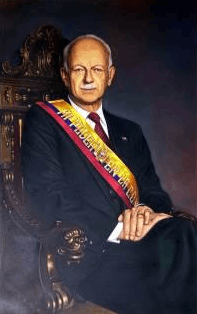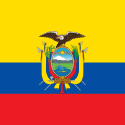Sixto Durán Ballén
| Sixto Durán-Ballén | |
|---|---|
 | |
| 37th President of Ecuador | |
|
In office August 10, 1992 – August 10, 1996 | |
| Vice President |
Alberto Dahik (1992–95) Eduardo Peña (1995–96) |
| Preceded by | Rodrigo Borja |
| Succeeded by | Abdalá Bucaram |
| 12th Mayor of Quito | |
|
In office August 1, 1970 – February 16, 1978 | |
| Preceded by | Jaime del Castillo |
| Succeeded by | Álvaro Pérez Intriago |
| Personal details | |
| Born |
Sixto Alfonso Durán-Ballén Cordovez July 14, 1921 Boston, Massachusetts, United States |
| Died |
November 15, 2016 (aged 95) Quito, Pichincha Province, Ecuador |
| Resting place | Church of Santa Teresita, Quito[1] |
| Nationality | Ecuadorian |
| Political party | Republican Union Party (1991–2016) |
| Other political affiliations | Social Christian Party (1951–91) |
| Spouse(s) | Josefina Villalobos (m. 1945–2016) (his death) |
| Alma mater |
Stevens Institute of Technology University of Wisconsin-Madison Columbia University |
Sixto Alfonso Durán-Ballén Cordovez (July 14, 1921 – November 15, 2016)[2] was an Ecuadorian political figure and architect. He served as Mayor of Quito between 1970 and 1978. In 1951, he founded a political party, the Social Christian Party.[3] In 1991, he left the Social Christian Party party and joined a newly formed conservative group, the Republican Union Party, before running for president for the third time in 1992.[4]
Ballén was elected as President of Ecuador in 1992. He served as congressman in 1984 and again in 1998. Under his campaign slogan, "Ni un paso atrás" (Not one step back), he helped to modernize the Ecuadorian economy while facing challenges from the World Bank and oversaw and resolved the Cenepa War during the last years of his presidency.[5] He received positive ratings, upon leaving office four years later on August 10, 1996. His presidency was seen favorably by the public polls, but received mixed opinions from scholars.[6][7]
Early life
Ballén was born on July 14, 1921, in Boston, Massachusetts.[8] He was born while his parents, Sixto Durán-Ballén Romero and Eugenia Cordovéz y Cayzedo, were on a diplomatic mission in the United States.[4]
Ballén studied at San Jose La Salle College in Guayaquil. At first, Ballén pursued a career in architecture and went to study abroad at the Stevens Institute of Technology in Hoboken, New Jersey, at the University of Wisconsin-Madison and at Columbia University.[9][10]
He married Josefina Villalobos in 1945.[11]
Early political career
Durán was one of the founders of the Catholic Social Christian Party (PSC).[3] Under the presidency of his party colleague Camilo Ponce Enríquez, he served as minister of public works from 1956 to 1960. Subsequently, he worked for the Inter-American Development Bank.[3] He was elected Mayor of Quito in 1970 and re-elected in 1974.[12]
In 1979 he ran as the PSC's presidential candidate, but was defeated by the populist Jaime Roldós Aguilera. In 1988 he ran again, but was eliminated in the first round, which he blamed on the tarnished image of León Febres Cordero's government.[3]
Presidency (1992–96)
1992 Ecuadorian presidential election
At the end of 1990 he publicly criticized the direction of the PSC in an open letter and, after a PSC faction succeeded in appointing Jaime Nebot as the its presidential candidate and national director during the 1991 internal elections (despite opinion polls reportedly giving him advantage over Nebot),[6]
Ballén and his supporters left the party to form the more right-wing Republican Union Party.[13] They subsequently entered into an alliance with the Conservative Party.[14] Eventually, Durán defeated Nebot in the second round of the 1992 presidential election.[15]
Tenure
Ballén was inaugurated president on August 10, 1992.[1] At age 71, Ballén was the oldest person to have served as president.[11] During his time as president, he actively pursued structural reform to modernize the Ecuadorian state and cut down wasteful bureaucratic spending.[16] During his presidency, Ballén lowered the Ecuadorian inflation from 67% to 24%.[17] The result was a significant reduction of government deficits and a thriving private sector.[17] Durán-Ballén also led Ecuador into membership in the WTO, with negotiations being led by his subsecretary of Foreign Affairs, Patricio Izurieta Mora-Bowen.[11] The admission to the WTO had a significant impact on the nation's political institutions and export competitiveness.[11]
During his presidency, there was criticism towards Ballén's economic policies.[18] Many analysts agree that all these actions carried out under his economic plan meant the prelude to almost absolute insolvency to which the country would arrive in 1998 with an external debt of 16.4 billion dollars.[17] He also faced harsh criticism when he eliminated the External Credit Committee in 1995 and was accused of abuse and subjection to public indebtedness.[19] In response to the corruption allegations against him, Ballén called for a second popular referendum to allow reforms as per modernization of the state, which were largely rejected.[16]
Ballén faced challenges while attempting to secure the modernization of the Ecuadorian economy from the World Bank.[20] The World Bank insistent on the privatization of public services which resulted in the reduction of jobs, the elimination of alleged subsidies and the profitability of the Ecuadorian state management.[20]
In 1995, Ballén proved to be one of Ecuador's most successful war-time leaders when his determined leadership united a divided country under the theme Ni un paso atras which means "not a single step backwards" during the Cenepa War with Peru.[15] His last years as president, he focused on the resolution of the Cenepa War with President of Peru Alberto Fujimori.[21] The war ended with both nations withdrawing troops on December 28, 1995, a few months before Ballén left office.[22]
On August 10, 1996, Ballén was succeeded by Abdalá Bucaram. Upon leaving office, Ballén was praised by the public opinion, while his economic policies and his involvement in the Cenepa War, caused his presidency to have mixed opinions from scholars.[6]
Post–presidency (1996–2016)
Following his presidency, Ballen was elected deputy for the Pichincha Province in 1998. Between 2001 and 2003, he served as an ambassador to the Court of St. James in London.[23]
.jpg)
In 2005, he wrote an autobiography titled A mi manera... Los años de Carondelet and edited by the publisher of the Universidad Andina Simón Bolívar. In 2006, he appeared as a candidate for the Andean Parliament for the Christian Democratic Union, but was not elected.[24]
Death
Ballen died in his sleep at his home in Northern Quito on the night of November 15, 2016, from natural causes at the age of 95.[25][26] He is survived by his wife Josefina and their eight children.[25]
His state funeral was held on the following day on November 16 at Quito's city hall.[27] His funeral procession later conclude at a religious service at the Cathedral of Quito.[1] The incumbent president, Rafael Correa attended the funeral and declared three days of national mourning.[28] Former president Gustavo Noboa and Ballén's first vice president, Alberto Dahik, were also those in attendance.[29] His remains were later buried in a vault at the Church of Santa Teresita in Quito.[1]
Legacy
Ballen's term in office was also characterized by a continued political stalemate with a Congress led by his former party.[30] It spearheaded many of the corruption allegations against his administration and members of his family, accused of illicit enrichment, in cases such as "Flores y Miel" ("Flowers and Honey").[15] The impeachment of his Vice President Alberto Dahik, for allegedly using public funds illicitly, further weakened his stance.[31]
References
- 1 2 3 4 "Sixto Durán Ballén será velado en el Salón de la Ciudad del Municipio de Quito". El Comercio.com. November 15, 2016. Retrieved November 19, 2016.
- ↑ "Former President of Ecuador Sixto Durán Ballén Dies at 95". Washington Post.com. November 16, 2016. Retrieved November 16, 2016.
- 1 2 3 4 "Tormenta en el partido social cristiano". Explored.com.ec. Retrieved September 20, 2015. (Spanish)
- 1 2 "Former Ecuador President Duran-Ballen Dies at Age 95". The New York Times. November 16, 2016. Retrieved November 16, 2016.
- ↑ "Hace 20 años fue el conflicto del Alto Cenepa". El Universo.com. January 26, 2015. Retrieved January 26, 2015. (Spanish)
- 1 2 3 "Presidente Duran-Ballen atento en su oficina". Expolred.com. Retrieved September 20, 2015.
- ↑ "El libro que resume la bitácora arquitectónica de Sixto Durán-Ballén". El Comercio.com. Retrieved September 20, 2015.
- ↑ "Biography of President Sixto Duran Ballen". Hipecuador.htm. Retrieved November 17, 2016. (Spanish)
- ↑ Catherine M. Conaghan. "Unsettling Statecraft: Democracy and Neoliberalism in the Central Andes". Retrieved November 16, 2016.
- ↑ James Brooke (December 4, 1994). "The World; Latin Leaders Speak Gringo". Retrieved November 16, 2016.
- 1 2 3 4 "President Sixto Duran Ballen". CIDOB.org. Retrieved November 17, 2016.
- ↑ Morrisson, Christian (ed.) (1994), The Political Feasibility of Adjustment in Ecuador and Venezuela, OECD Publications Centre, p. 44
- ↑ "Ideario y estructura de Union Republicana". Explored.com. Retrieved September 20, 2015.
- ↑ "Partido conservador y unidad republicana mantienen una alianza y no una adhe". Explored.com. Retrieved September 20, 2015.
- 1 2 3 "Sixto Durán Ballén". Buscabiografias.com. Retrieved September 20, 2015.
- 1 2 Diana Jean Schemo (November 7, 1995). "Political and Energy Crises Foil Ecuador's Hopes". The New York Times.com. Retrieved November 16, 2016.
- 1 2 3 "1994 Ecuadorian Economic Report". United States Department of State. April 16, 1994. Retrieved November 17, 2016.
- ↑ "Former Ecuadorian President Sixto Duran Ballen Dead at 95". The Times of India. November 16, 2016. Retrieved November 16, 2016.
- ↑ "Ecuador and the IMF -- Address by Stanley Fischer". IMF.org. May 22, 2000. Retrieved November 15, 2016.
- 1 2 Weber, Gabriela (2008). Sobre la Deuda Ilegítima. Quito, Ecuador. p. 74-84.
- ↑ "Sixto Durán no se arrepiente del 'Ni un paso atrás'". La Republica.ec. Retrieved September 20, 2015.
- ↑ "Alto Cenepa War, 1995". Teachwar.com. March 4, 2012. Retrieved November 19, 2016.
- ↑ "El Parlamento Andino no tiene facultad legislativa". La Hora. October 6, 2006. Retrieved October 4, 2016. (Spanish)
- ↑ "Sánchez preside el Parlamento Andino". El Universo. October 7, 2007. Retrieved 21 September 2016.(Spanish)
- 1 2 "Falleció en Quito el expresidente Sixto Durán Ballén". El Universo.com. November 15, 2016. Retrieved November 15, 2016. (Spanish)
- ↑ "Former Ecuador President Duran-Ballen Dead at 95". Fox News.com. November 16, 2016. Retrieved November 16, 2016.
- ↑ "El expresidente Sixto Durán Ballén falleció este martes 15 de noviembre". El Comercio.com. November 15, 2016. Retrieved November 16, 2016. (Spanish)
- ↑ "Rafael Correa autoriza a la Cancillería y a Defensa organizar funeral de Estado para Sixto Durán Ballén". El Comercio.com. November 16, 2016. Retrieved November 16, 2016.
- ↑ "Políticos de varias tendencias reconocen valía de Sixto Durán Ballén". Ecuavisa.com. November 16, 2016. Retrieved November 16, 2016. (Spanish)
- ↑ "Muere el expresidente de Ecuador Sixto Durán Ballén a los 95 años". CNN en Español. November 16, 2016. Retrieved November 17, 2016. (Spanish)
- ↑ "Sixto el Maleifico de la corrupcion". Explored.com. Retrieved September 20, 2015.
External links
| Wikimedia Commons has media related to Sixto Durán Ballén. |
- Official Website of the Ecuadorian Government about the country President's History
- Biography of Sixto Durán Ballén
- Biography by CIDOB (Spanish)
- Interview with former president Sixto Durán Ballén on YouTube
- Exclusive interview with Sixto Durán Ballén
| Preceded by Rodrigo Borja |
President of Ecuador 1992–1996 |
Succeeded by Abdalá Bucaram |
